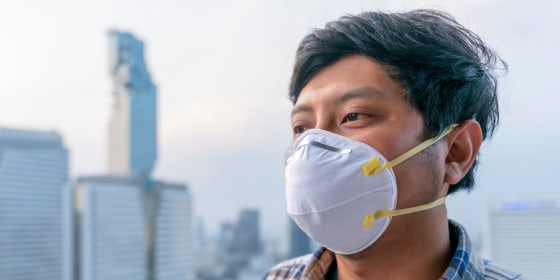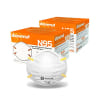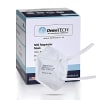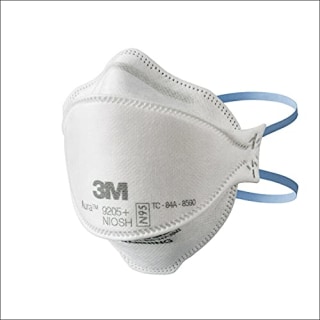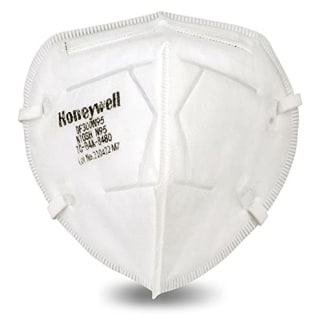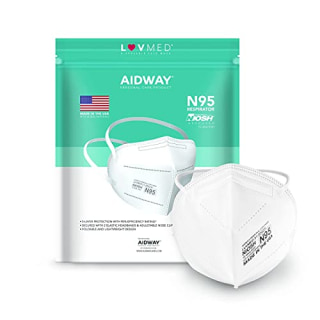Out of all the different face masks you can choose from, one type is the most protective, according to the Centers for Disease Control and Prevention: N95 respirators. They’re designed to filter out at least 95% of small and large airborne particles, and they fit tightly against your face to reduce gaps around the sides, chin and nose area. Plus, N95s are regulated in the United States by the National Institute for Occupational Safety and Health (NIOSH), so they’re easier to shop for compared to similar international respirators like KN95s and KF94s. (Note that most people use “mask” and “respirator” interchangeably, but when the CDC and medical professionals say “respirator,” they specifically mean fitted face coverings with certified filtration, like N95s, KN95s and KF94s).
If you need to restock your supply of N95 masks, I spoke to medical experts about what to look for while shopping, how these respirators differ from other disposable face coverings and when to wear them. I also compiled highly rated NIOSH-approved N95s that are available to buy online.
SKIP AHEAD The best N95 masks to shop| How to wear N95 masks | When to wear a face mask |Why trust NBC Select?
Want more from NBC Select? Sign up for our newsletter, The Selection, and shop smarter.
How I picked the best N95 masks
While shopping for N95 masks, keep the following in mind:
- NIOSH approval: Since N95 masks are regulated by NIOSH, you should only purchase those listed on the agency’s list of approved models. “When NIOSH gives an N95 its stamp of approval, it means the respirator has met very specific requirements for testing,” says Dr. Stella Hines, an associate professor in the Division of Pulmonary and Critical Care Medicine at the University of Maryland School of Medicine. “It’s a quality assurance indicator that the respirator will perform as expected.” All NIOSH-approved N95s adhere to specific performance and quality requirements, including the ability to filter out at least 95% of large and very small particles (0.3 microns in size).
- Appropriate markings: Specific markings on an N95 mask indicate that it’s NIOSH-approved. These include identifying information verified using NIOSH’s Certified Equipment List, filter designations, model numbers and more.
- Features: N95 masks should have two straps that go around your head and an adjustable wire nose bridge to help ensure that the mask fits tightly against your face, according to experts. Never buy N95s made with exhaust ports, which holds true for all face masks, says Dr. David Rempel, a professor in the Department of Medicine at the University of California, San Francisco.
- Shape: N95 masks come in cup, flat fold and duckbill shapes. One is not better than the other, so experts recommend picking whichever you find the most comfortable.
- Type: N95 respirators labeled as ‘surgical’ or ‘medical’ should be prioritized for healthcare workers, according to the CDC. A standard N95 mask is sufficient for the general public.
The best N95 masks to shop
Numerous N95s meet NIOSH’s requirements, but the CDC recommends leaving surgical-grade masks for medical professionals. Excluding those options, I compiled highly rated NIOSH-approved N95 masks you can shop online. Note that some N95s come packaged together, while others are individually wrapped. All the masks listed below have an adjustable nose bridge and two headstraps.
3M Aura N95 Respirator (3-pack)
3M’s Aura foldable N95 respirator has a three-panel design and is made to be low profile around the nose and eye area to accommodate glasses. They come individually packaged and are sold in packs of three at minimum — you can purchase larger packs if needed.
Honeywell N95 Flatfold Disposable Respirator (20-pack)
Honeywell’s N95s fold flat when they’re not in use. Their adjustable nose clip has a foam cushion that helps create a tight seal against the face. Masks come in a pack of 20.
DemeTECH N95 Respirator (20-pack)
DemeTech’s N95s are designed with five layers of material and fold flat when they’re not in use. They come in a pack of 20.
Shawmut Protex N95 Respirator (10-pack)
You can purchase Shawmut N95 respirators in a pack of 10, 20 or 240. The masks are built with a piece of foam that lines the inside of the adjustable nose piece, which helps reduce eyeglass from fogging up. The N95s come in small and medium/large sizes.
BNX N95 Mask (50-pack)
BNX N95 masks fold flat when they’re not in use and have latex-free head straps. They come in a pack of 10.
Kimberly-Clark Kimtech N95 Pouch Respirator (50-pack)
The pouch design of these N95s creates a large breathing chamber, making it easier to talk while wearing the respirators, according to the brand. They come in a pack of 50.
Aidway NIOSH N95 Respirator
Aidway’s N95 mask has five layers of protection and a flat-fold design. You purchase the masks in packs of 10, 20, 50, 100, 500 or 1,000.
How to wear N95 masks
Regardless of the type of mask you wear, it won’t protect you or the people around you unless you wear it correctly. Make sure your mask completely covers your mouth and nose and fits tightly against your face to prevent gaps around the sides of the mask, nose and chin, according to the CDC.
“N95 respirators will provide the regulated, expected level of protection to the wearer only if there’s a good seal to the face,” says Hines. “You want a good seal so that all of the air that’s breathed in is pulled in through the mask body. That’s where all the filtration of particles and microbial contaminants occurs.”
You can do an at-home leak test with an N95 by putting it on and breathing out, says Rempel. If you can feel the air under your chin or around your eyes, it’s not tight enough. And if your glasses fog up while wearing an N95, there’s leakage and it’s not tight enough, says Hines.
All masks and models fit differently, and features like an adjustable nose bridge help you improve the fit of your mask, as do mask fitters or braces, according to the CDC. Using a fitter or brace is especially a good idea for people with facial hair, which can make it difficult to achieve a tight fit.
When should you wear a face mask?
There’s no nationwide mask wearing mandate in the United States, so it can be tricky to decide when you should wear one. Here’s what experts recommend — and remember, wearing a mask can help reduce the transmission of illnesses like the flu, RSV and the common cold, not just Covid-19.
- In crowded indoor spaces where you spend more than 15 to 20 minutes: Examples include concerts, grocery stores, classrooms and offices, as well as transportation hubs like airports and train stations, says Dr. Carl Fichtenbaum, a professor of clinical medicine at the University of Cincinnati College of Medicine. Wearing a face mask while traveling on a crowded plane, train or bus is also a good idea, he says.
- When you’re sick: You’re at the highest risk for transmitting a virus when you have a fever, so you should stay home, says Dr. Sharon Nachman, chief of the division of pediatric infectious diseases at Stony Brook Children’s Hospital. Once your fever gets better, or if you’re just coughing and sneezing, wear a mask if you absolutely have to go out in public, she says. Doing so makes it less likely that you’ll spread germs to others.
- If you’re at a higher risk for infection: That goes for people 65 and older, and those who have medical conditions or take medications that weaken their immune system, says Fichtenbaum.
- When there’s high levels of illness in your community: The CDC has Covid-19, flu and RSV trackers online that are open to the public, which Nachman recommends bookmarking. You can enter a zip code and see how present each illness is in your community or those you’re traveling to. If positivity is trending upward, that’s a sign that you should consider wearing a mask, especially in crowded indoor public spaces, says Nachman.
Meet our experts
At NBC Select, we work with experts with specialized knowledge and authority based on relevant training and/or experience. We also ensure that all expert advice and recommendations are made independently and with no undisclosed financial conflicts of interest.
- Dr. David Rempel is a professor in the Department of Medicine at the University of California, San Francisco.
- Dr. Stella Hines is an associate professor in the Division of Pulmonary and Critical Care Medicine at the University of Maryland School of Medicine.
- Dr. Carl Fichtenbaum is a professor of clinical medicine at the University of Cincinnati College of Medicine.
- Dr. Sharon Nachman is the chief of the division of pediatric infectious diseases at Stony Brook Children’s Hospital.
Why trust NBC Select?
I’m a reporter at NBC Select who has written about face masks since 2020, including articles about KN95s, N95s, disposable face masks and kid’s face masks. To write this article, I interviewed four doctors about how to shop for N95 masks and researched face coverings using resources from the CDC and NIOSH. I also recommended NIOSH-approved N95 masks to buy that meet expert guidance.
Catch up on NBC Select’s in-depth coverage of tech and tools, wellness and more, and follow us on Facebook, Instagram, Twitter and TikTok to stay up to date.
